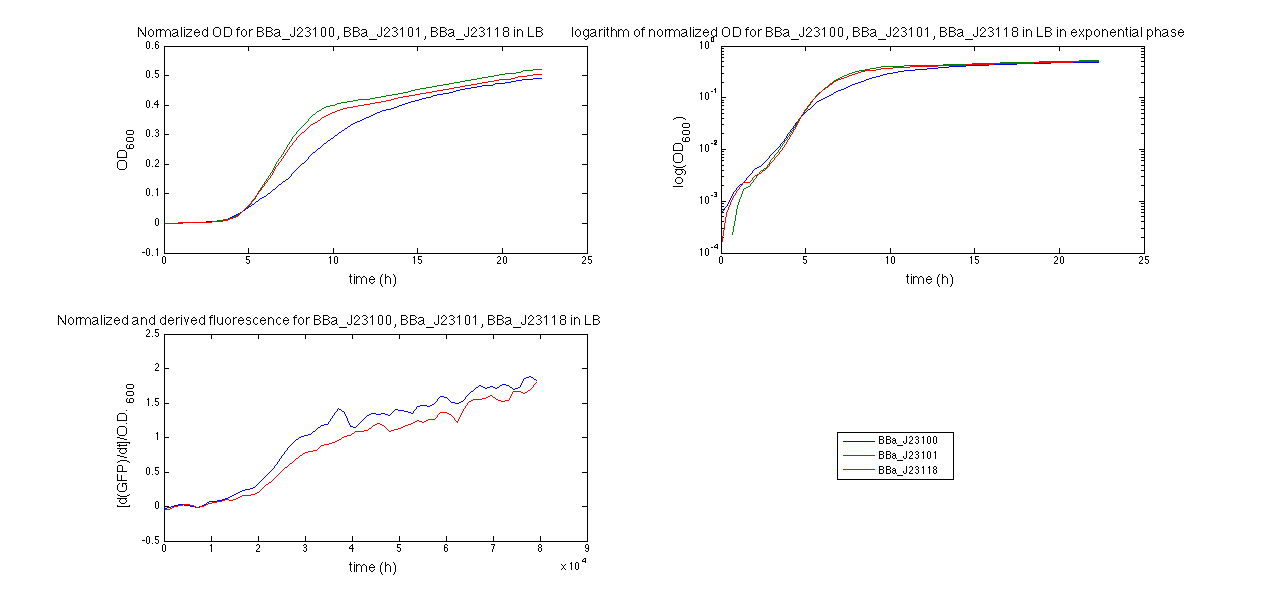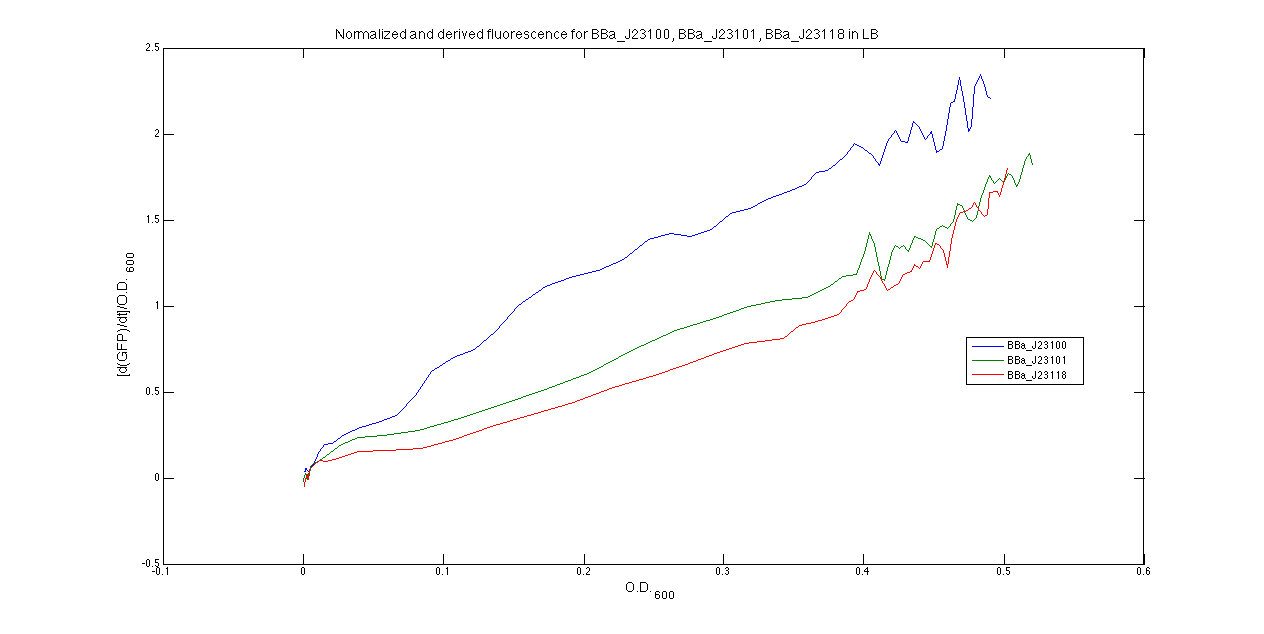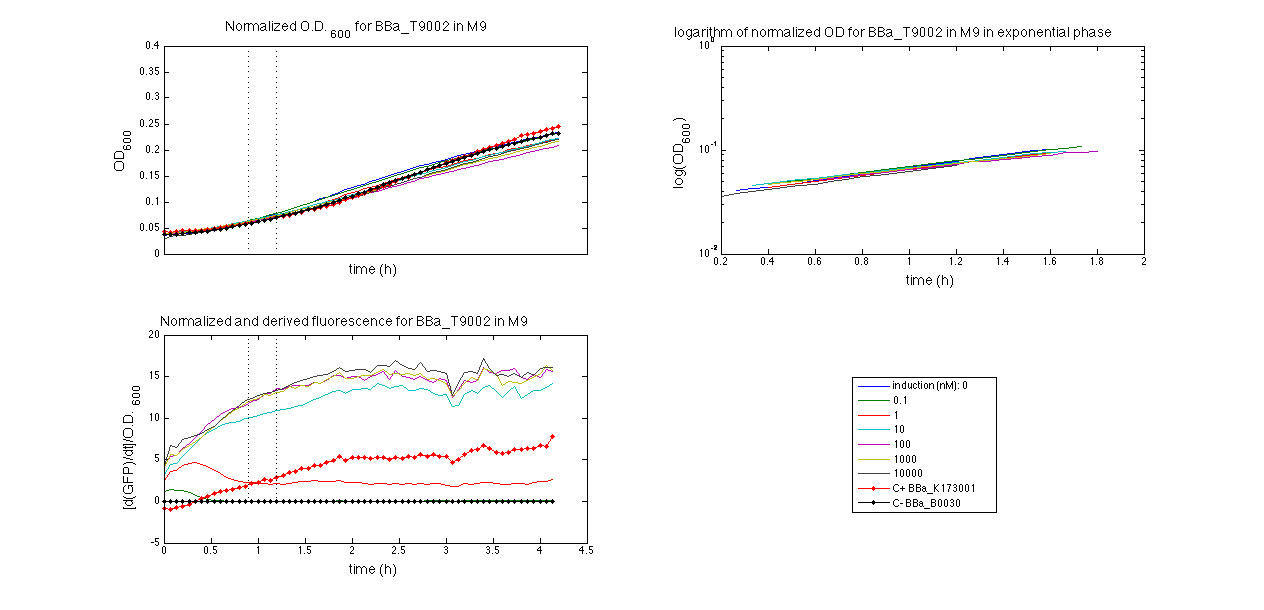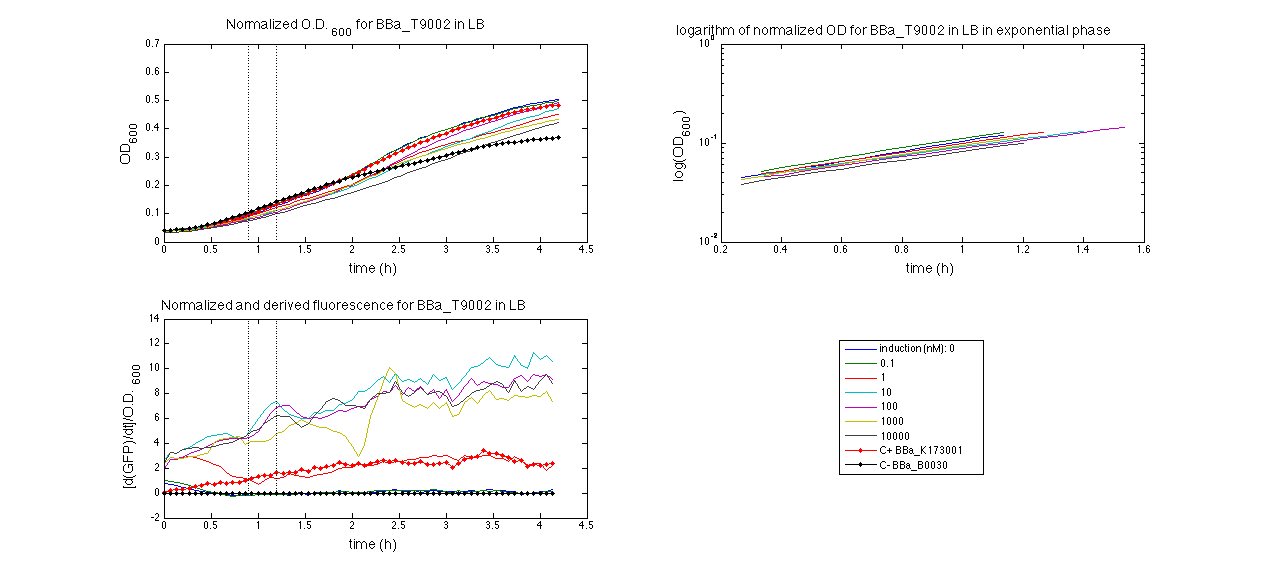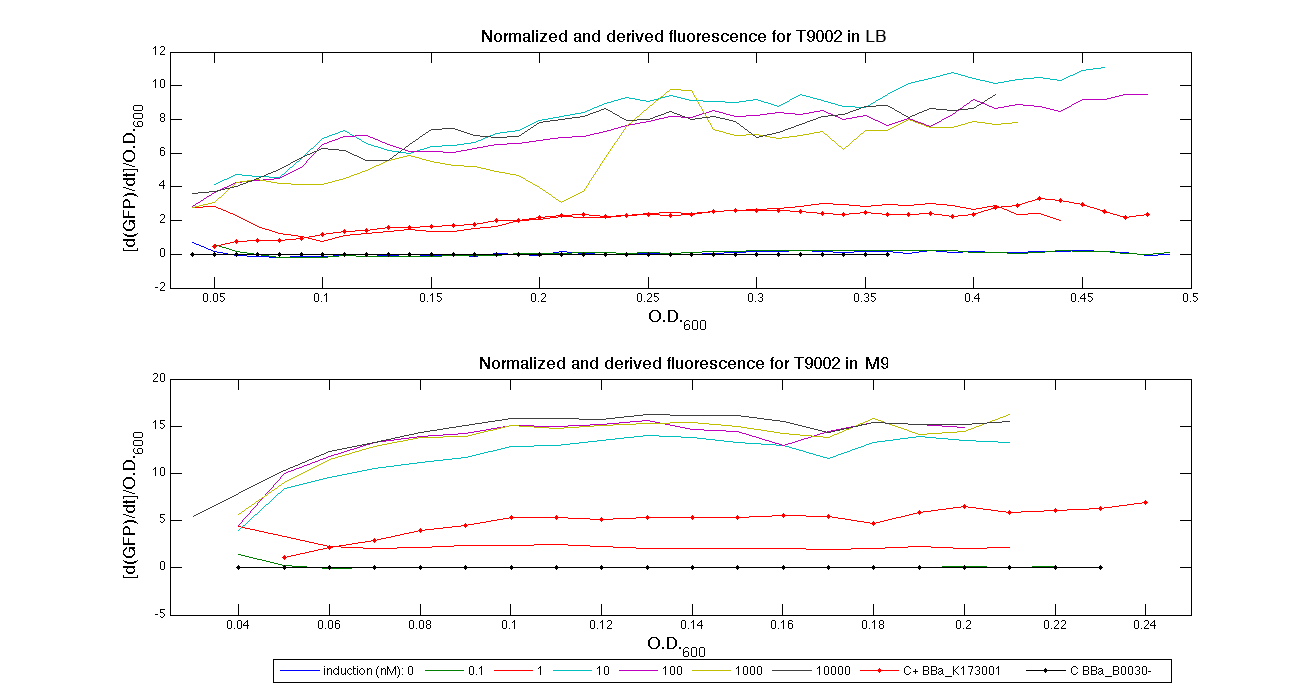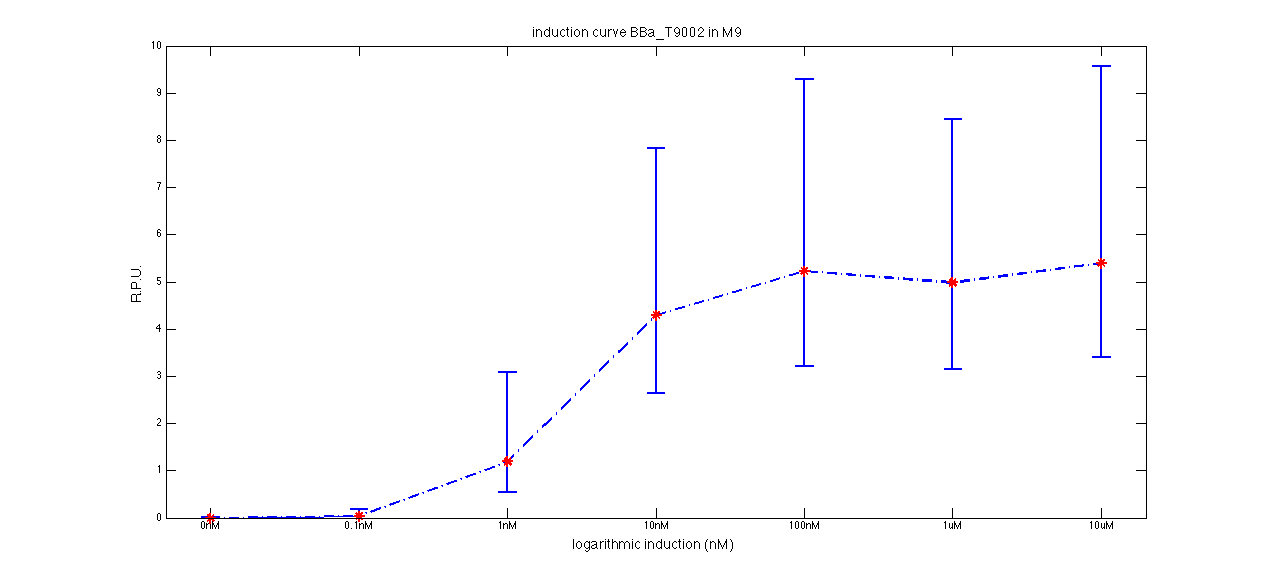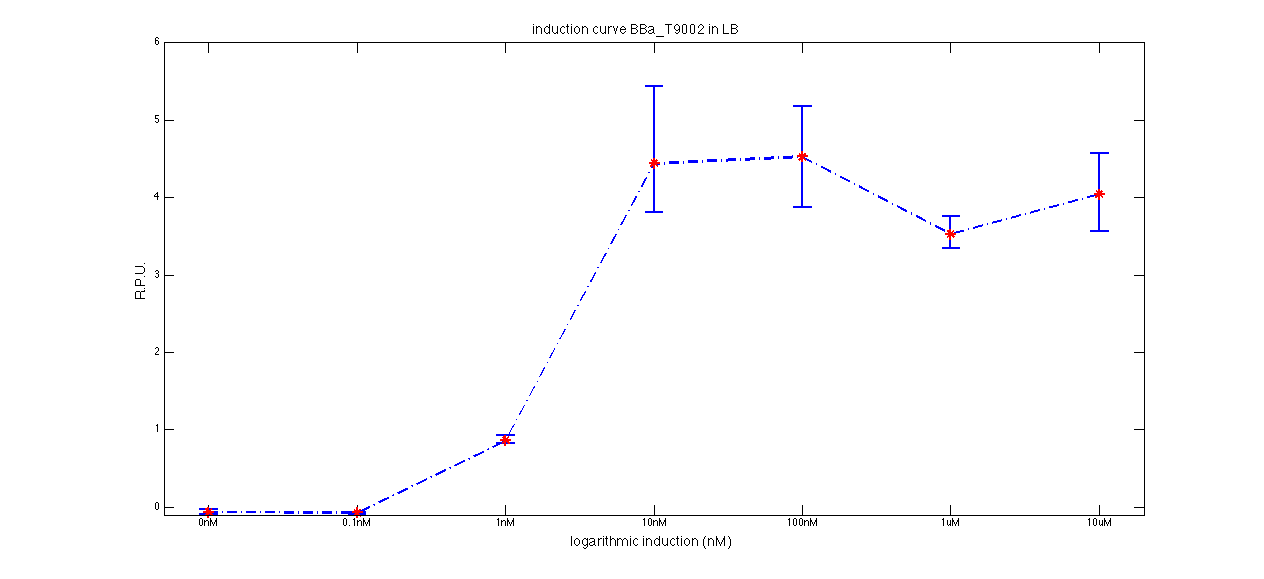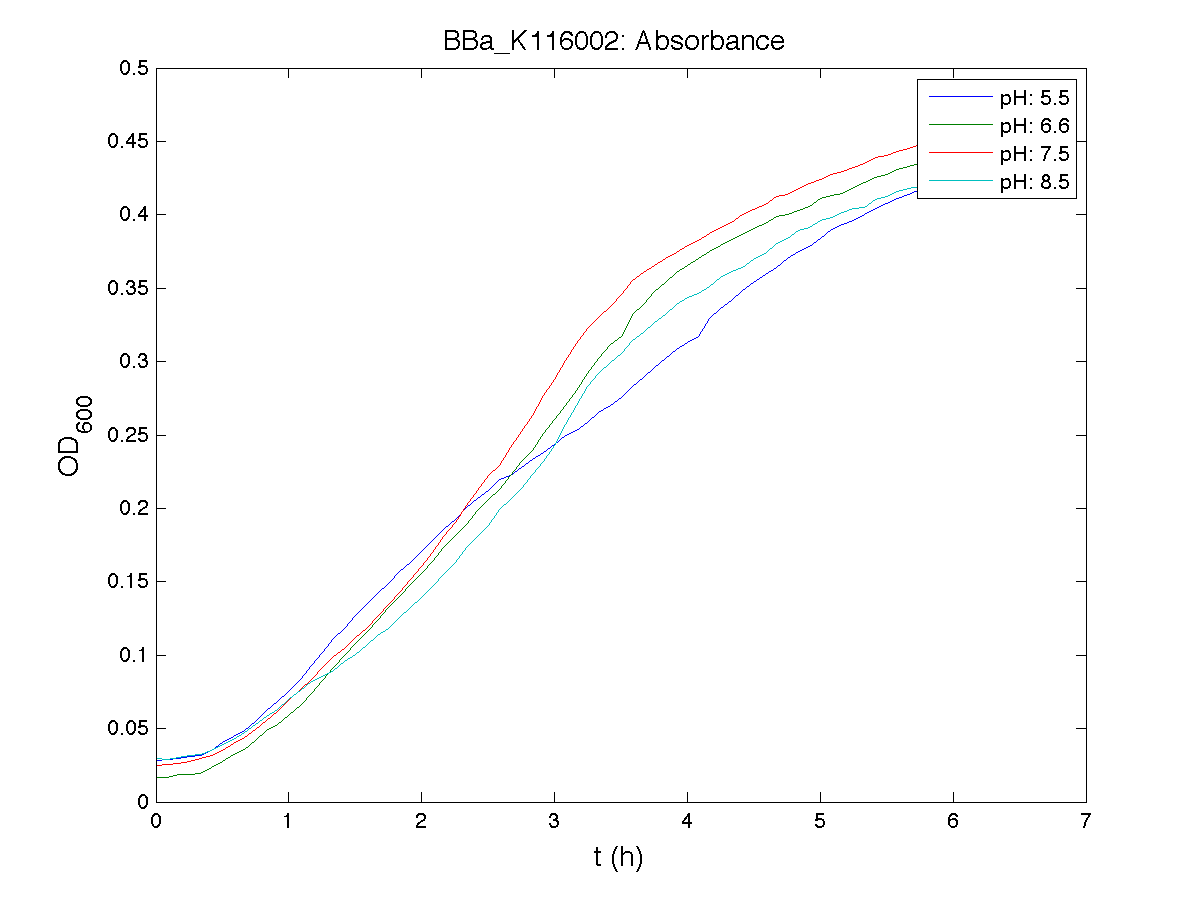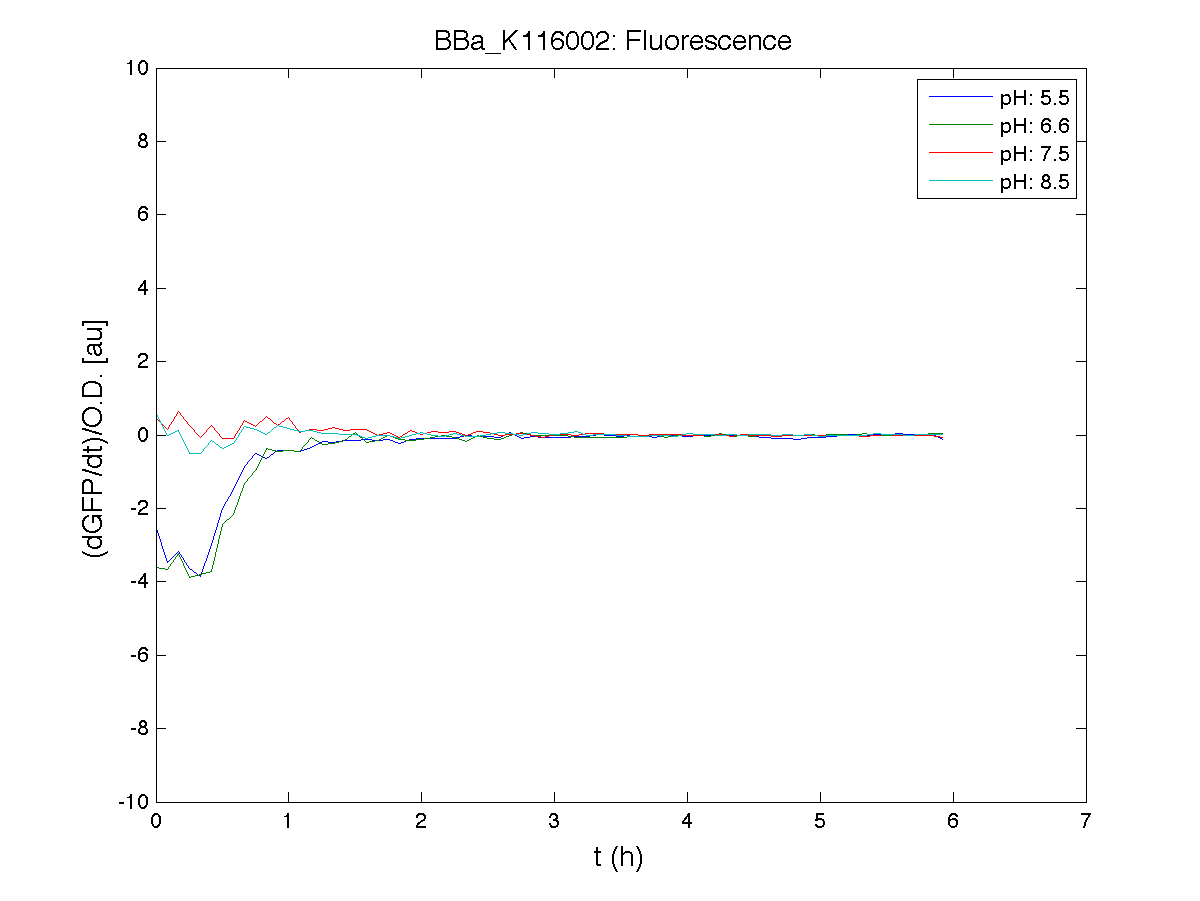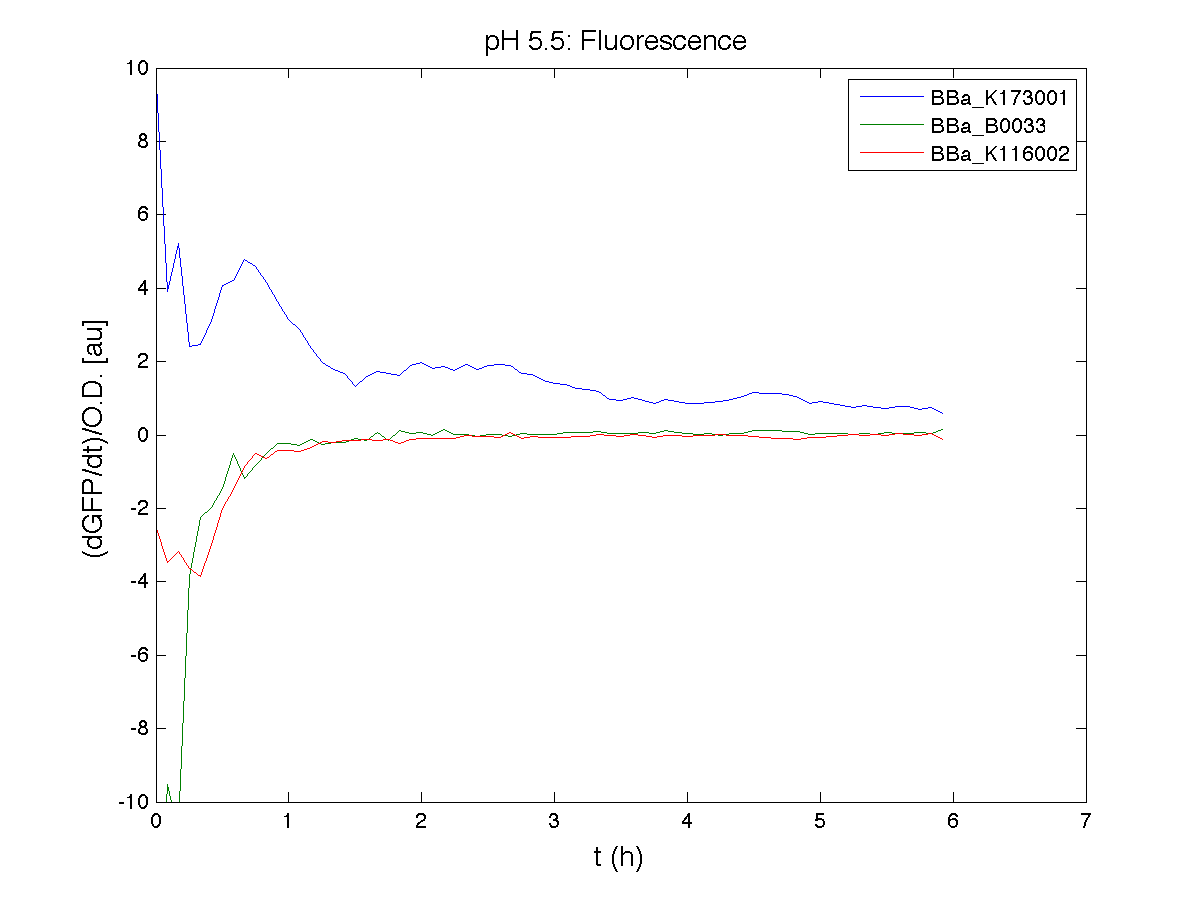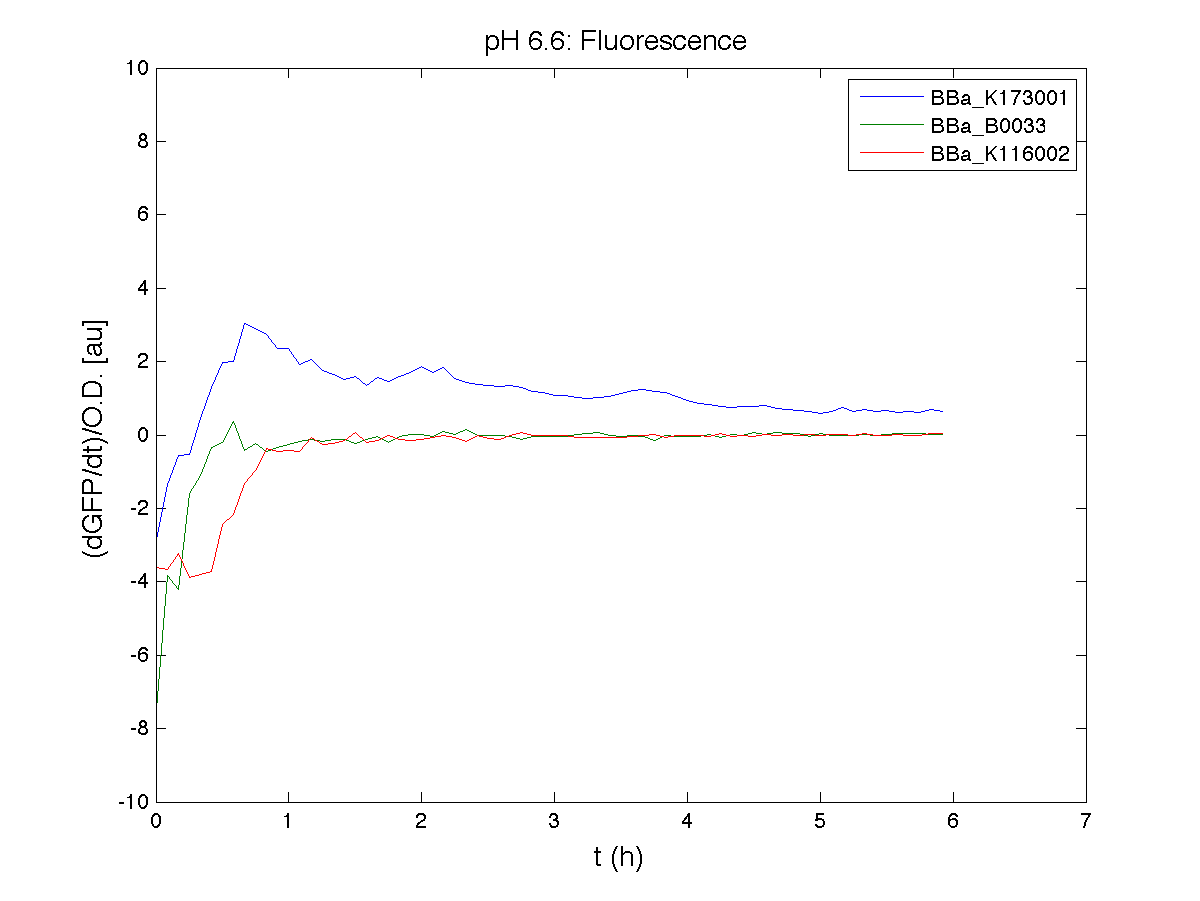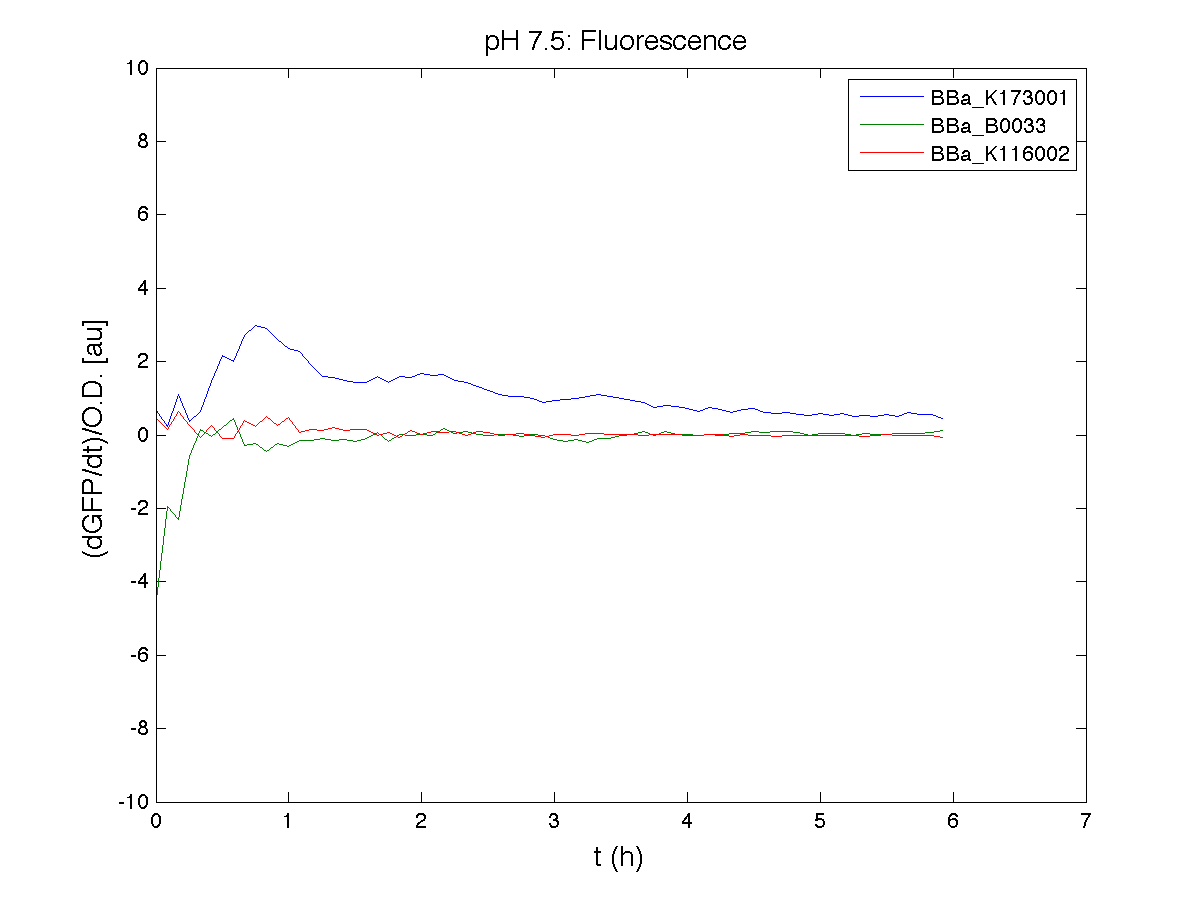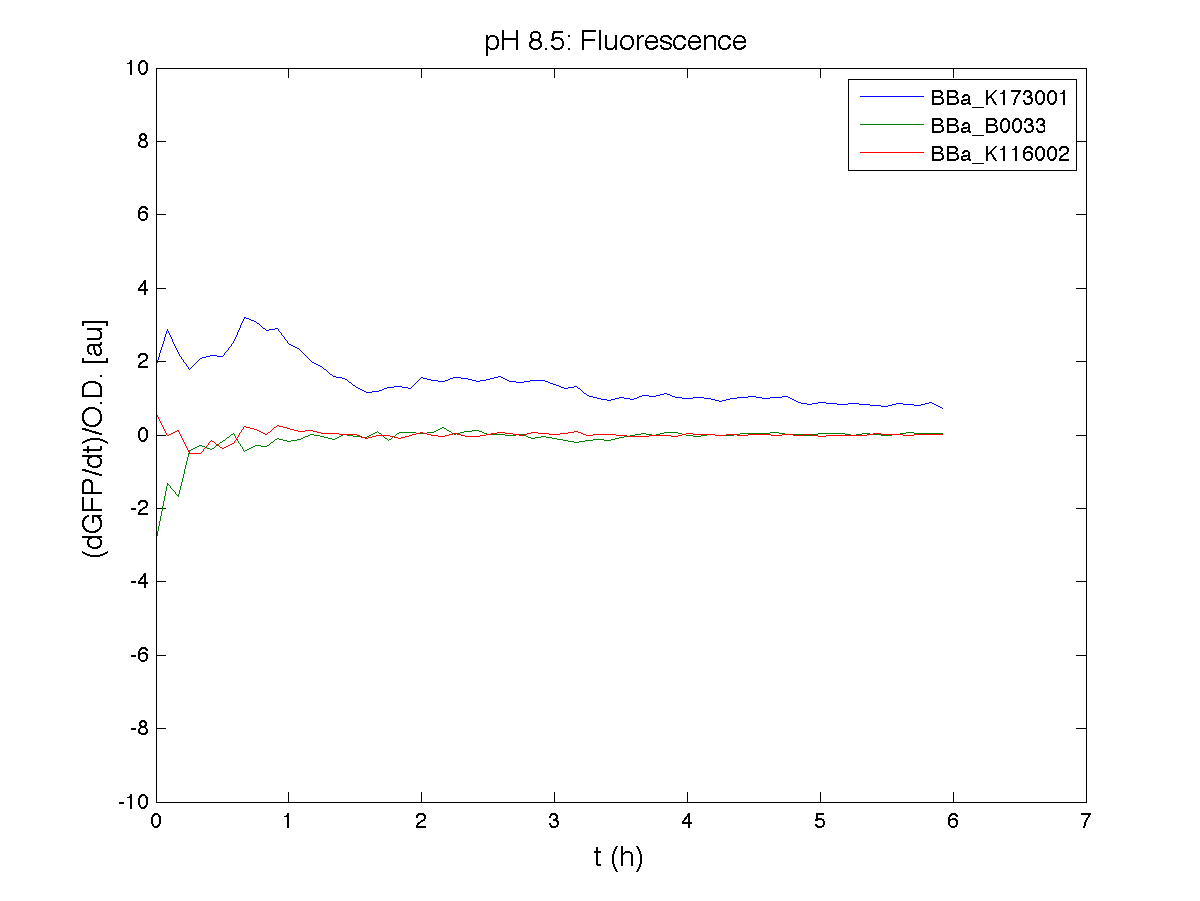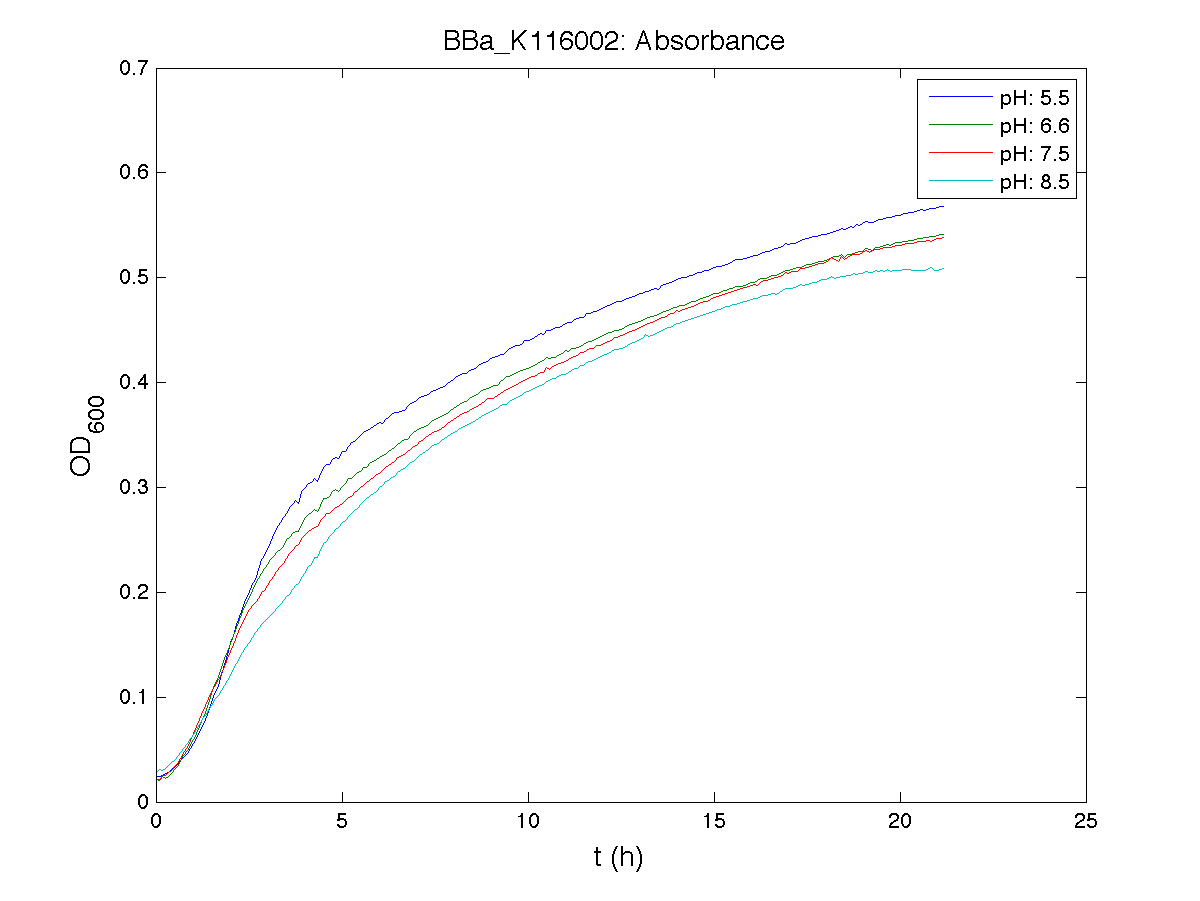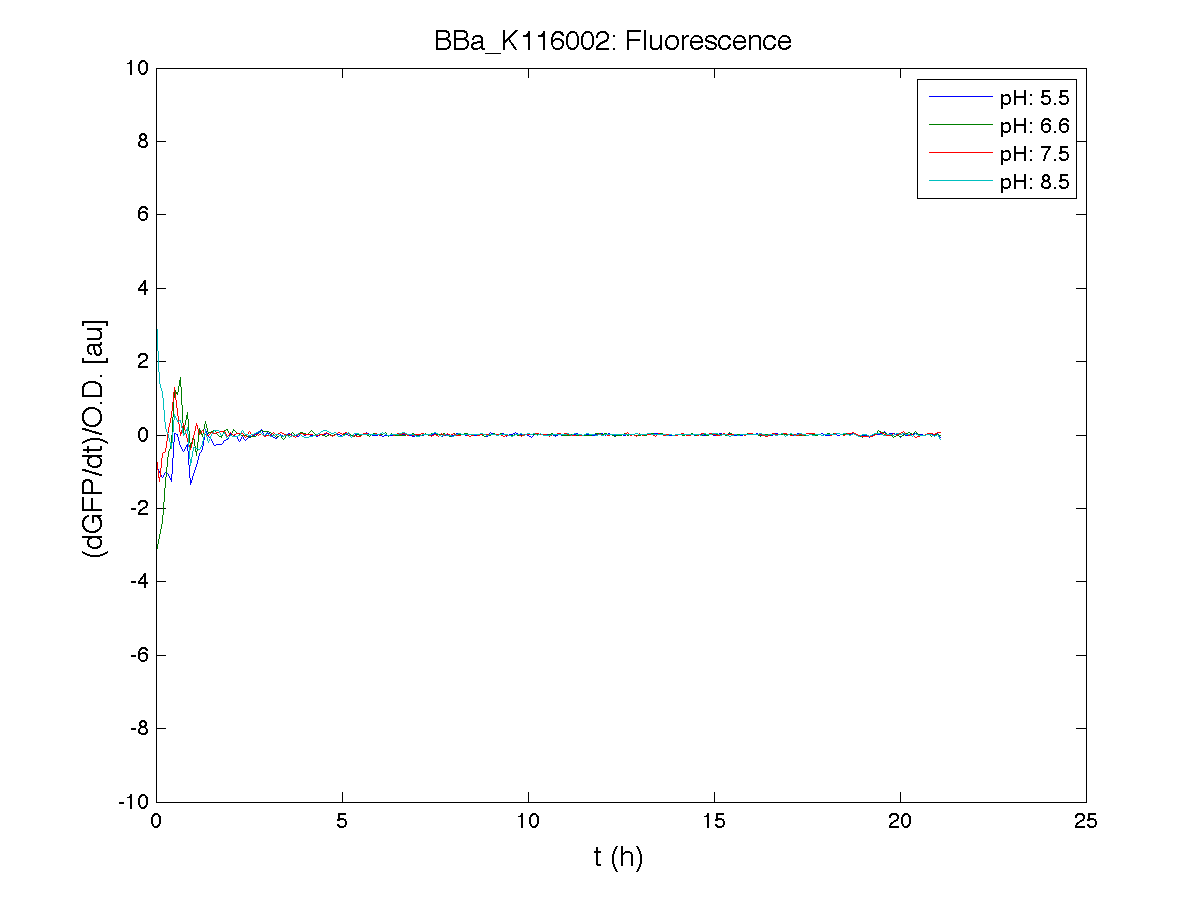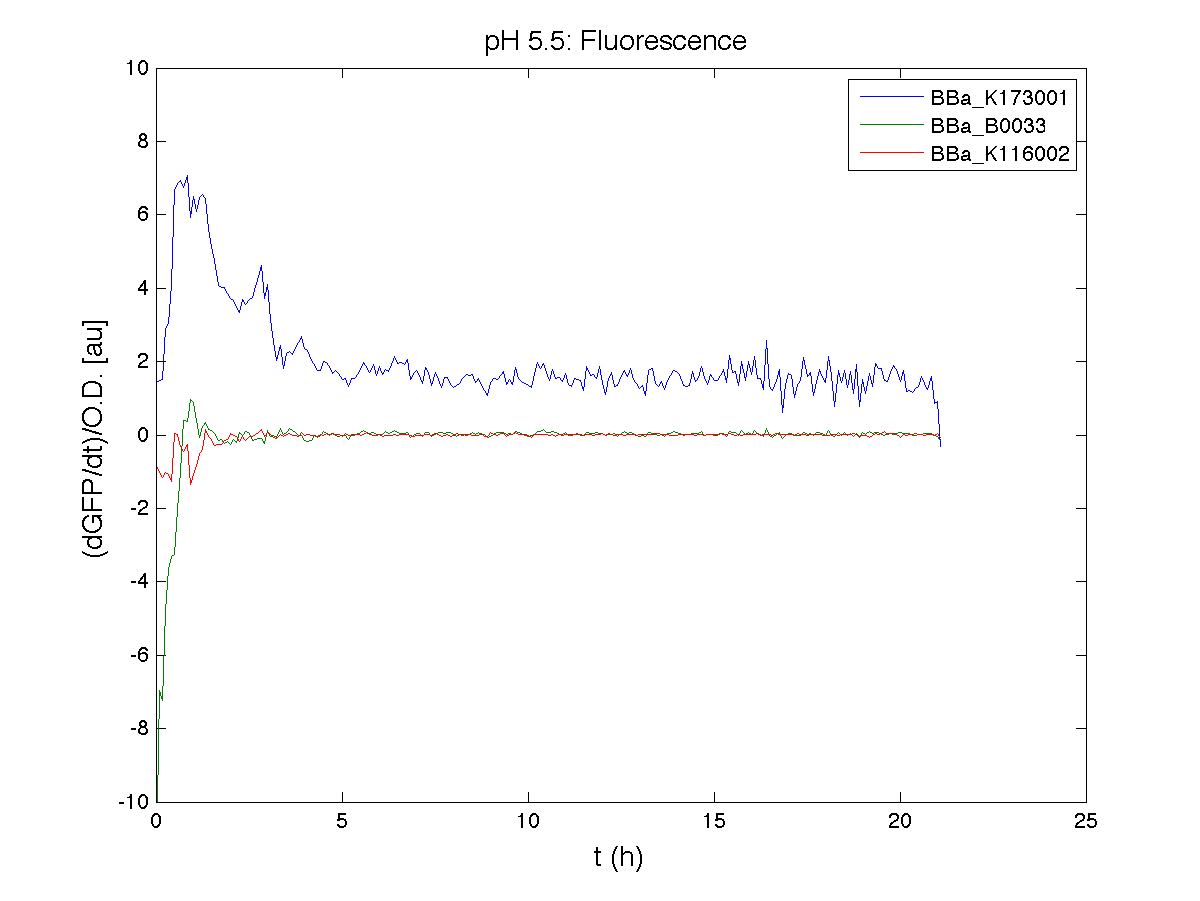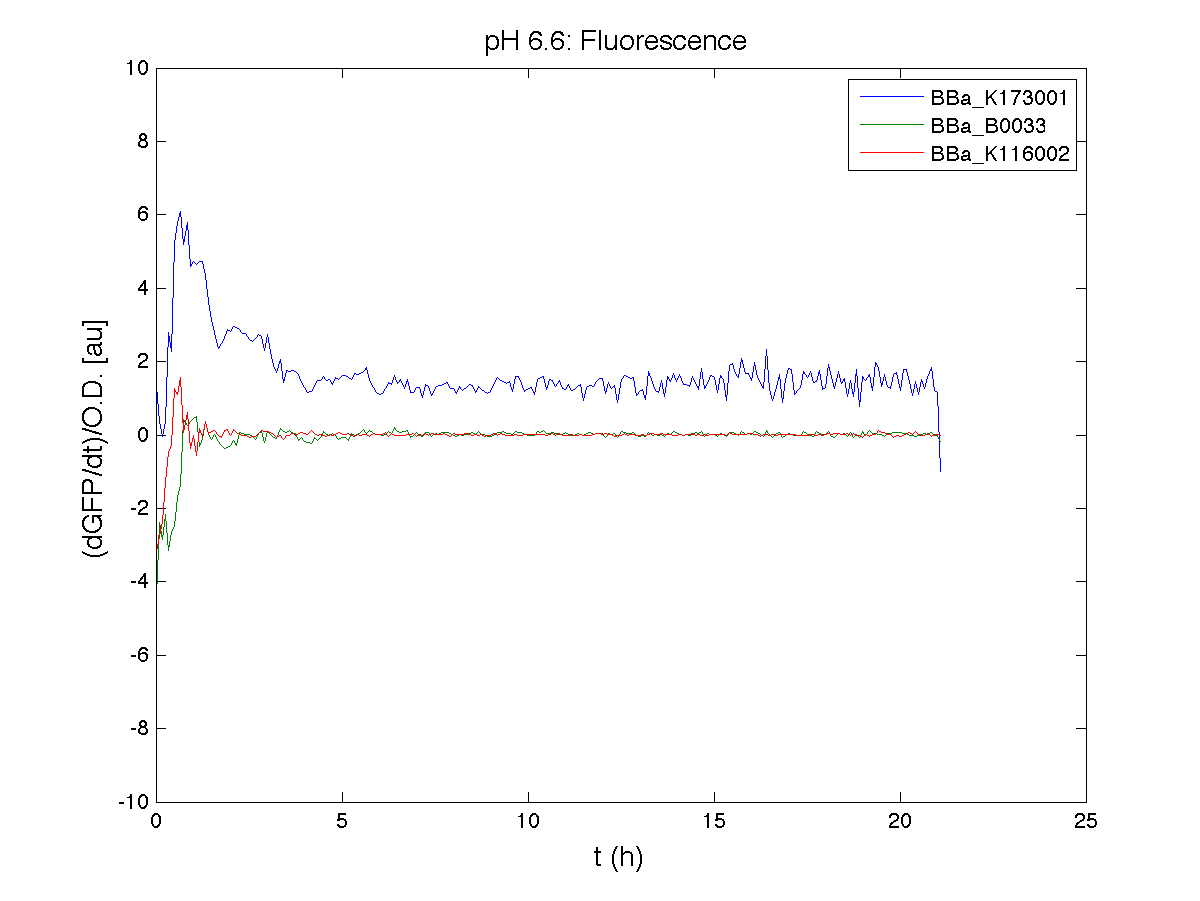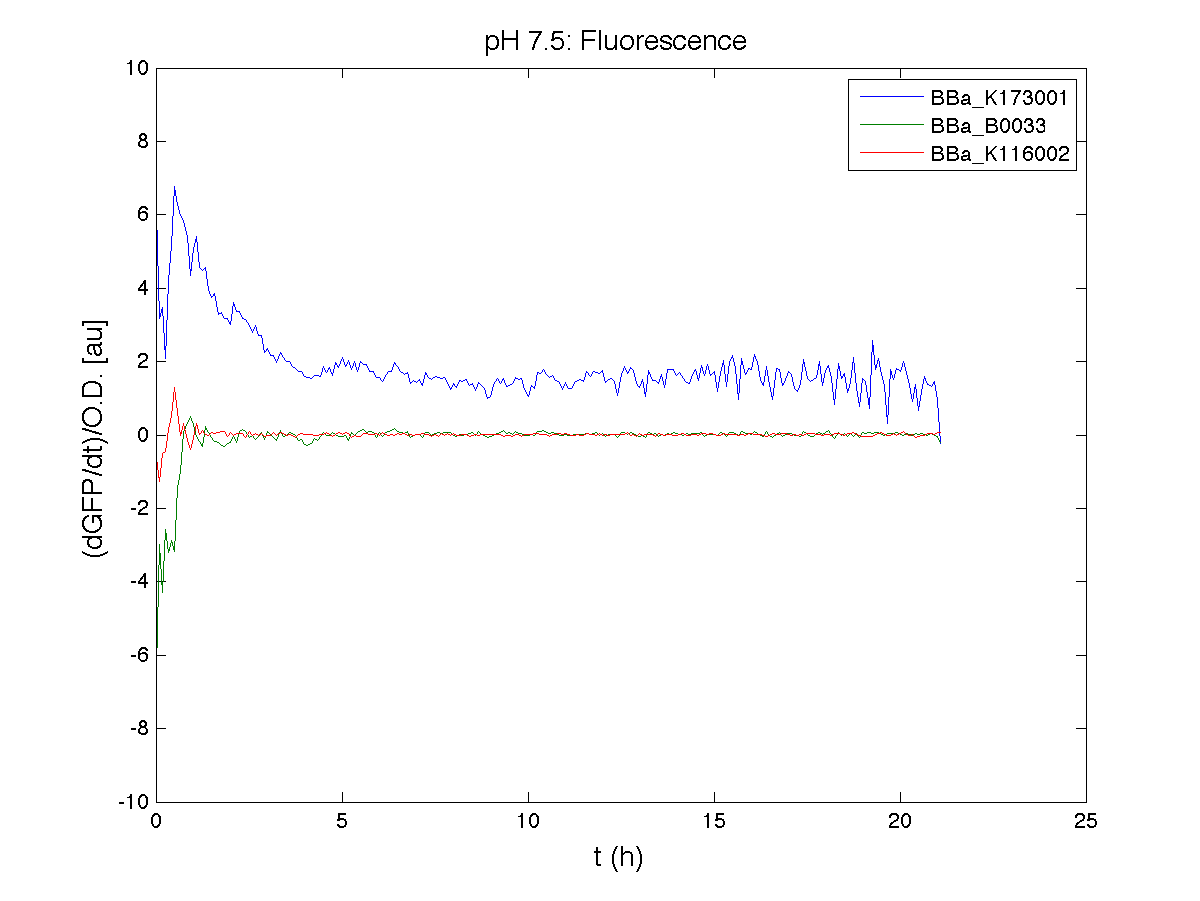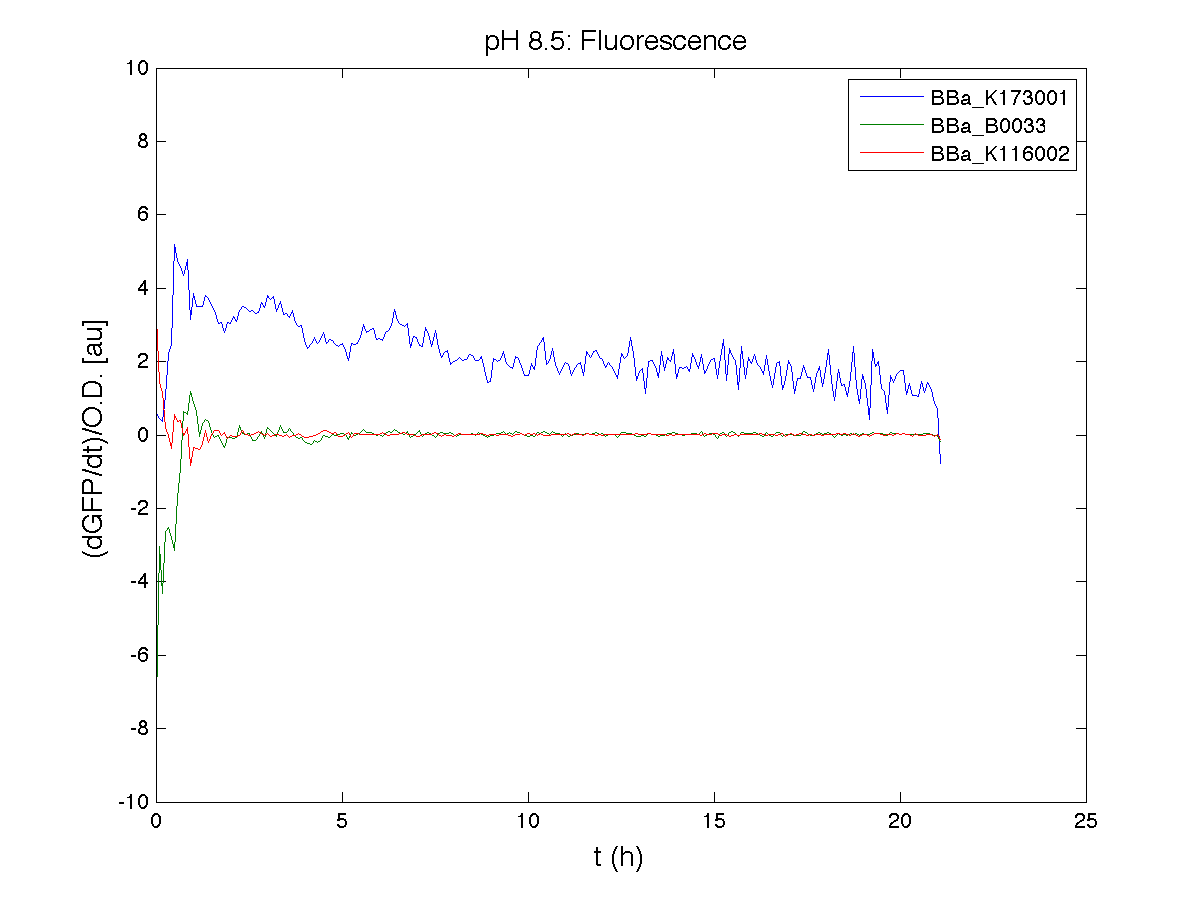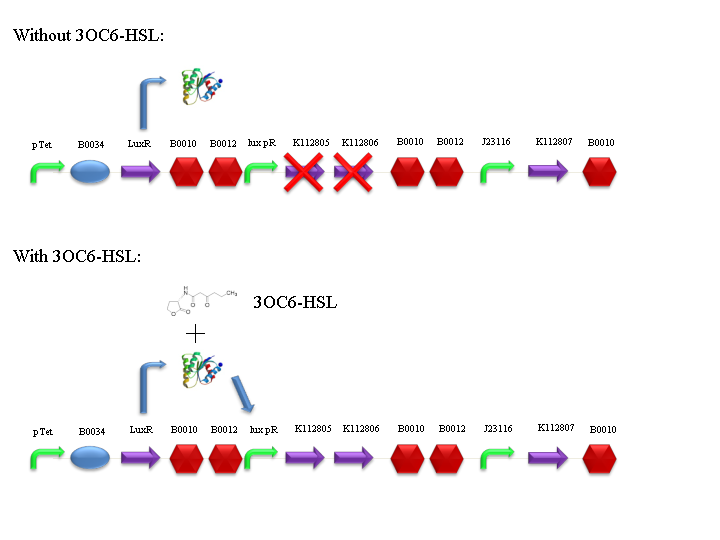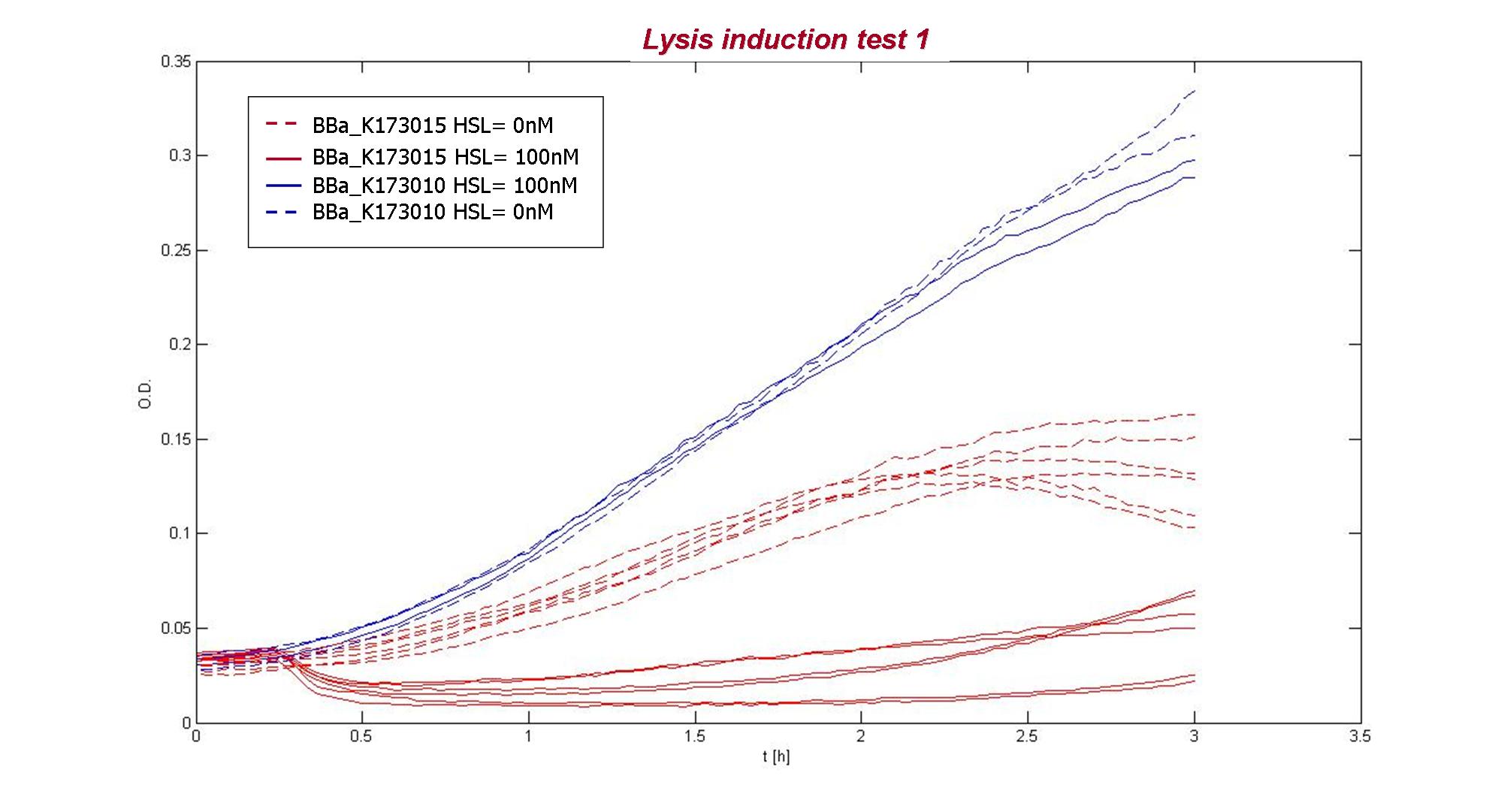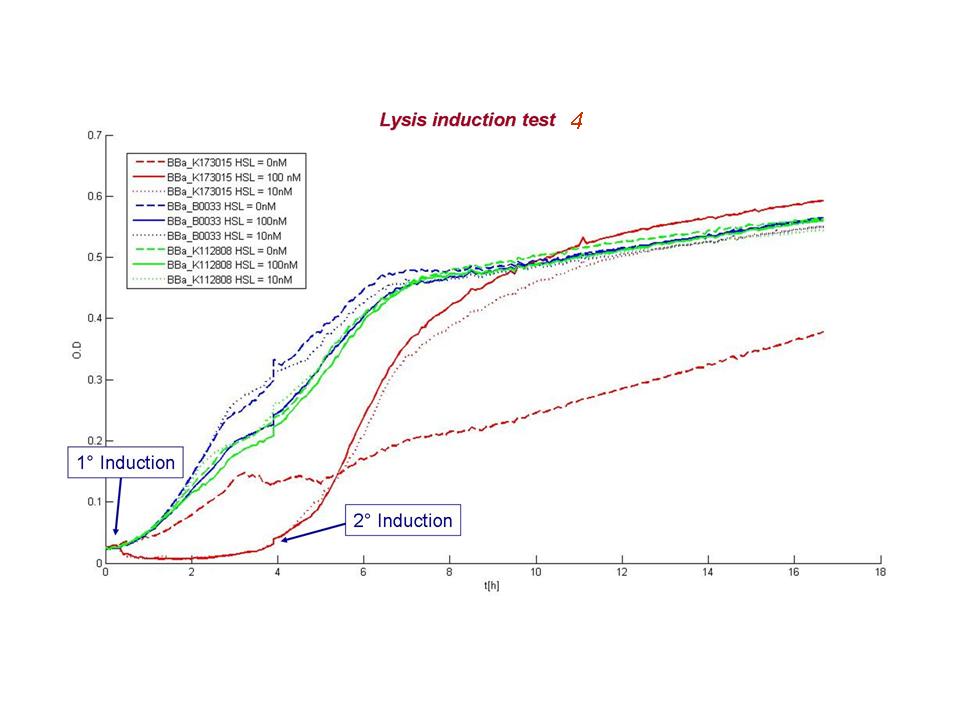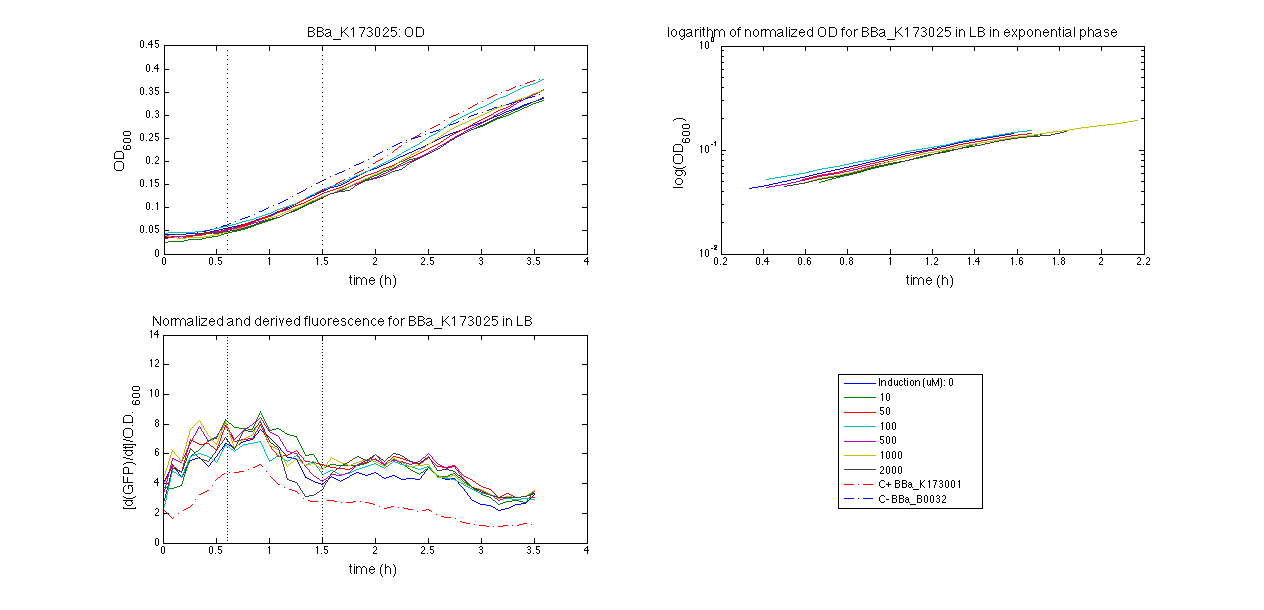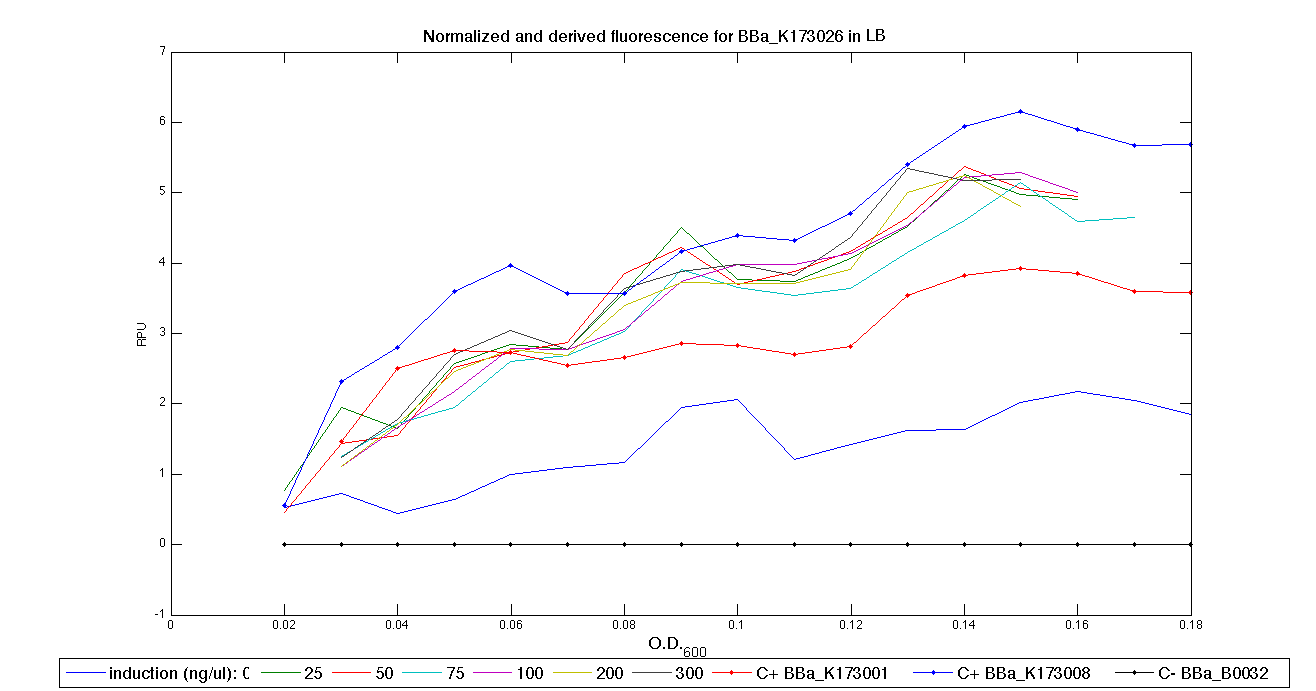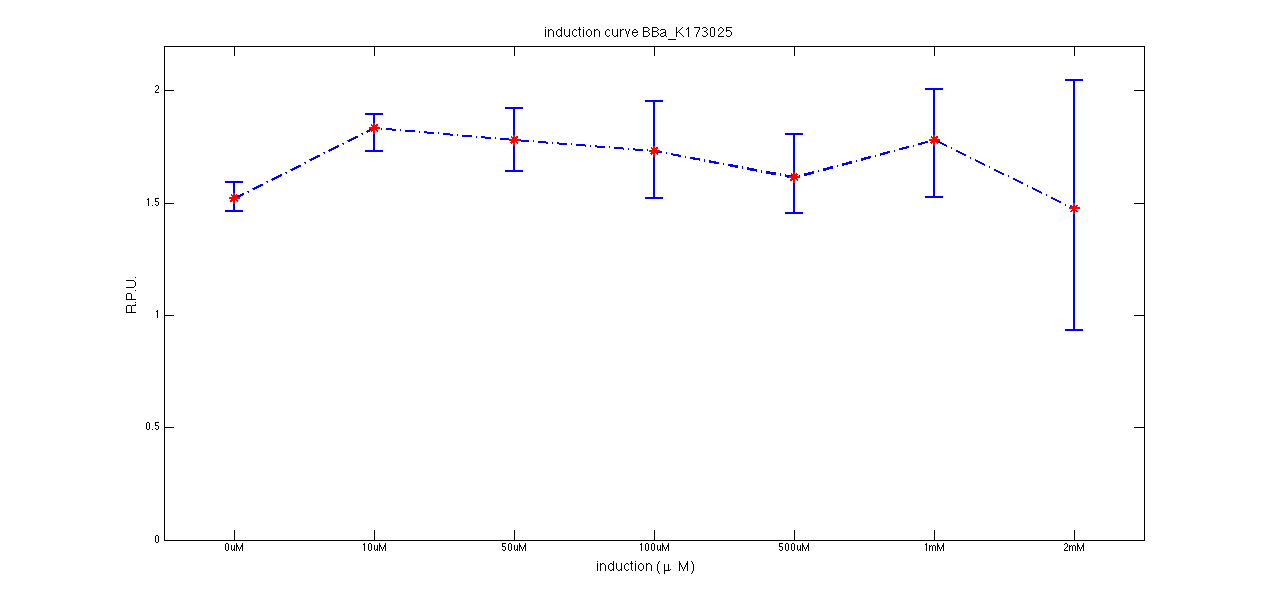Team:UNIPV-Pavia/Existing
From 2009.igem.org

|
|
|
Existing parts: registry |
||||||||||||||||||||||||||||||||||||||||||||||||||||||||||||||||||||||||||||||||||||||||||||||||||||||||||||||||||||
|
Re-built existing parts (BBa_our part code/BBa_existing part code) Existing parts from the Registry:
Existing parts: sequence debugging
BBa_J23100, BBa_J23101, BBa_J23118 - constitutive promoter family membersDescriptionThese three promoters are from the Anderson Promoter Collection, which is a library of constitutive sigma70 bacterial promoters. The strength of each promoter of the library has already been estimated in saturation growth phase cultures in LB, but here we provide the characterization of BBa_J23100 and BBa_J23118 in standard units (RPUs) in LB medium, in order to add experience and data for these BioBricks. BBa_J23101 is the reference standard promoter, so it has RPU=1 for definition. The data shown below are referred to , and that are the measurement parts of , and respectively. Characterization
ConclusionsRPU estimation of these promoters was not present in the Registry and even the doubling time of these parts was not documented. We added these data in the pages of , and characterized parts, hoping that they can be useful for promoter comparison in standard units. If we consider the promoter ranking, provided in saturation phase in the [http://partsregistry.org/Promoters/Catalog/Anderson Anderson Promoter Collection Registry page], the estimated strength in RPU of BBa_J23100 and BBa_J23118 are in accordance with this ranking (see ). Note: plasmid is equals to pSB1A2 with a RFP expression system downstream of the cloning site. BBa_F2620 - 3OC6HSL receiver deviceDescriptionThis device gives PoPS as output and can be induced with 3OC6-HSL autoinducer molecule: it binds luxR protein (encoded by ), which is constitutively expressed by tetR promoter (). LuxR-HSL complex can work as a transcriptional activator for lux promoter (). Several studies have been performed on this BioBrick. Here we provide the experimental characterization we performed during this summer. The tests have been performed through measurement system, which has a GFP protein generator downstream. Characterization
ConclusionsThe induction curve of the receiver device, reported in page (M9 supplemented medium), was represented in PoPS units, while ours is reported in RPUs and has been obtained through a very similar protocol (see Growth conditions section). Anyway, the experiments we performed in M9 supplemented medium confirmed the induction curve shape of this device, with a switch point between 1nM and 10nM. We also estimated the transfer function of this device in LB medium, for which no data were reported in the Registry from previous characterization. More experiments sholud be perfomed on the behaviour of this device in M9 because the one performed show a great variation in RPU range. BBa_K116001 - nhaA promoterfrom iGEM 2008 NYMU-Taipei We received the BioBrick measurement system (which has a GFP protein generator downstream) of from iGEM HQ in September (it is called ). The bacterial strain that contained the plasmid was NEB 10-beta, so we decided to transform it into E.coli TOP10. We wanted to perform some experiments to better understand how it works and if can be successfully used. We performed several experiments with different LB medium and we got almost the same results. We used:
Here we show just two experiments to explicate our work. You can download the complete list from this link. Experiment Na+ 0MMotivationIn our opinion the working principle of the antiporter Na+/H+ channel described in [Rachel Karpel et al., Etana Padan et al., N. Dover et al.] makes the nhaA promoter a Na+ sensor and only under certain conditions (presence of Na+) a pH sensor. Methods
ResultsCommentsAs expected didn't produce any GFP. So we can consider it a Na+ sensor and only secondarily a pH sensor. Experiment Na+ 250mMMotivationWe’ll try again to make E.coli producing GFP at the variation of pH. Methods
ResultsCommentsWe didn't expect this. After looking better for a motivation in some articles ([Rachel Karpel et al.]) we think this could be because of the E.coli strain: we use TOP10 while a special strain (delta-pump) without some membrane proteins that regulate E.coli homeostasis is used in other experiments. Final considerationsIn our opinion this sensor (primarily sodium sensor and secondarily pH sensor) needs very particular conditions to work (first of all a specific bacterial strain) we couldn’t reproduce, so we consider it almost unusable. BBa_K112808 - Enterobacteria phage T4 Lysis DeviceDescriptionActually a lysis device such as is not part of "Ethanol? Whey not!" project. Anyway, we found very interesting to characterize the activity of this BioBrick and we decided to do it by building up a specific measurement system: , in which we can modulate the expression of the lysis genes through inducible device. During this summer we have also characterized in standard units, so the characterization of the lysis device is device-independent. receiver device controls the expression of holin () and lysozyme () genes from T4 bacteriophage. Holins form pores in the inner membrane of bacteria, while lysozymes degrade the peptidoglycan layer, passing through these pores and performing the lysis of the bacterial cell. This device also contains a constitutive expression of an antiholin (), which inhibits holin multimer formation. Lysis can be induced with 3OC6-HSL autoinducer molecule: it binds luxR protein (encoded by ), which is constitutively expressed by tetR promoter (). LuxR-HSL complex can work as a transcriptional activator for lux promoter (). CharacterizationWe performed four experiments on our measurement system () in order to characterize activity. All the experiments have been performed in the same conditions in the microplate reader and involved the induction of with 3OC6-HSL 10 nM (which corresponds to a RPU value of ? in LB for BBa_F2620) and 100 nM (which corresponds to a RPU value of ? in LB for BBa_F2620). The basic activity of BBa_F2620 was ? RPU. O.D.600 has been used to measure the amount of bacteria in the wells. Experiment 1 results We tested and as a negative control. These two parts were tested according to [Microplate reader experiments] section, except for first inoculum, which was performed from single colonies in a streaked LB agar plate. Three colonies were tested separately for this part. The result showed that BBa_K173010 had comparable growth curves in presence of HSL (dashed blue lines) or not (blue lines). The cultures containing the lysis device not induced (dashed red lines) shows a slow growth compared to BBa_K173010, maybe because of leakage of the inducible system causing a weak lysis or because the device decrease bacteria’s fitness. The colture containing the induced lysis device (red lines) shows a rapid decrease of O.D. after 15 minutes from induction, followed by a O.D. gaining. Different colonies had comparable dynamic growth.
The growth curves of the second experiment are in agreement with the result of Experiment 1. Moreover, our hypothesis of mutant generation for induced colture is confirmed by the second induction: if the increase in O.D. was perhaps due to a shortage of HSL in the growing population, the second induction would have caused a new decline in O.D., which is not our case. This hypotesis is also confirmed by the growth curves of induced (ast t=0) cultures, which shows a decrease (from 15 min to 2 hours) followed by an increasing growth, comparable with the negative controls' and faster than non induced cultures'. This new experiment also shows that both induction with 10nM or 100nM of HSL cause the same decrease in O.D. value and that K112808 part alone (green lines) could grow like the negative control, demonstrating that the slow growth of was actually due to leakage activity of . ConclusionsWe built up a new measurement system to characterize a particularly interesting lysis device, already present in the Registry. The reported results show that the lysis device works as expected when gene expression of the lysis genes is triggered. The performed experiments showed a genetic instability of this device (which was expected because a complete expression system of lysis genes is introduced in E. coli): in one of four experiments lysis could not be induced (Experiment 2) and in all the other experiments after lysis induction in cultures showed an O.D.600 decrease, followed by a fast increase, probably due to mutations in lysis expression system. BBa_R0011 - Plac hybrid promoterDescriptionThe hybrid lac promoter (BBa_R0011) has been designed taking the Plambda promoter (BBa_R0051) and substituting its cI (BBa_C0051) binding sites with two lacI binding sites. This promoter can be repressed by lacI (BBa_C0012), which can be repressed by lactose or IPTG, providing a lactose/IPTG inducible system. Differently from wild type lac promoter, this part does not have any CAP binding sites, so its behaviour is glucose-independent. Even if lacI is not expressed in this BioBrick, strains bearing a genomic copy of lacI can repress this promoter, which acts as a glucose-independent lactose/IPTG sensor. In the other strains BBa_R0011 acts as a constitutive promoter. Here we provide the characterization of this promoter in E. coli TOP10, which has a lacI genomic copy, constitutively expressed in a weak manner. The data below are referred to , which is the measurement system of . Characterization
ConclusionsAs TOP10 strains contains an expressed lacI in its genome, we wanted to know if it was enough to repress Plac activity in a high copy number plasmid in order to use it as a lactose/IPTG sensor. It is evident from induction curve that the behaviour of this part is almost independent from IPTG concentration, probably because lacI production is by genomic DNA is too low. So our characterization as shown that can be used as a strong constitutive promoter, with mean RPU higher than 1.5. Future work should be dedicated to the characterization of this BioBrick in low copy number plasmids and in strains containing lacIq mutation in order to buil-up new IPTG/lactose sensors. |
|||||||||||||||||||||||||||||||||||||||||||||||||||||||||||||||||||||||||||||||||||||||||||||||||||||||||||||||||||||
 "
"

